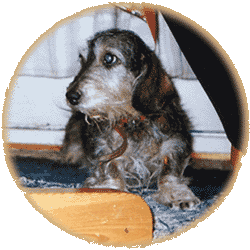|
My first contact with Salukis was through my grandmother who gave
me a set of Swedish Kicki-books when I was 8 years old. Kicki had
a cream feathered Saluki called Tazi, a Saudi Arabian import and the
real heroine of the books. I feverishly devoured every detail of Tazi
and her life, her personality, her running career and her puppies,
imagining how it felt to stroke their bony backs. Something about
it all enchanted me completely and I decided that one day I too would
breed Salukis.
Dog
breeding as such was not unfamiliar to me as my family and relatives
are Dachshund fanciers. Several Dachsie litters were born in my home
and I was allowed to witness the births and help care for the dogs
from the very beginning. For 15 years I shared my childhood and early
teens with a wire-haired Dachsie bitch, Kivitorpan Grogga (Ali von
Helvesiek x Black Spot Wyntermoon), who was about 6 months my senior.
Grogga had three litters for my uncle Berndt Åström's Groggens-kennel
(the M-, P- and S-litters). Grogga shared my bed from the crib onwards
and was my best friend, a great personality whom we still miss.
After
Grogga's death my family went without a dog for about 6 months until
we could not bear it any longer. In -87 we purchased a longhaired
Dachsie bitch, Ahotorpan Valentiina (Waiki vom Felsenhugel x Ahotorpan
Paola), a.k.a. "Tiiti". She had a litter by Comans Joonatan
in -89 from which we kept her son "Tennari", officially
known as Amadeus. Tiiti and Tennari in turn surprised us with an unexpected and
unplanned litter in -95, from which I had two neutered boys, Bacchus
and Balzac a.k.a. "Nando". Nando passed on to greener pastures and
Bacchus was rehomed in 2004. He became depressed after his brother's
death, but in his new home has a Dachsie buddy once more and is
enjoying life again. My mother still breeds Dachsies, having moved on
to short-haired miniatures.
My
kennel name Qashani stems partly from my first Saluki Akasha's name,
as Qashani means "my Qasha" in Finnish. Qashani is also
Arabic and means porcelain or china which is decorative, utilitarian
and needs to be treated with care - just like the Saluki.
|
